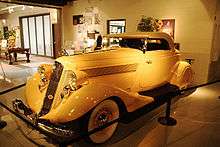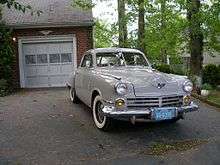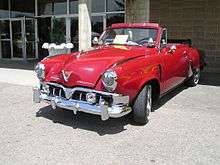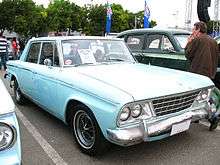Studebaker Commander

The Studebaker Commander is the model-name of a long succession of automobiles produced by the Studebaker Corporation of South Bend, Indiana (United States) and Studebaker of Canada Ltd of Walkerville and, later, Hamilton, Ontario (Canada). Studebaker began using the Commander name in 1927[1]:p258 and continued to use it until 1964, with the exception of 1936 and 1959-63. The model-name was applied to various positions in the company's product line-up from year to year.
History
1920s
Until the appearance of the 8-cylinder President in January 1928, all Studebaker cars of the 1920s were sixes. There were three basic models — the Light, the Special and the Big Six, developing 40 bhp (30 kW; 41 PS), 50 bhp (37 kW; 51 PS), and 60 bhp (45 kW; 61 PS) respectively at 2000 rpm. The first Commander, in 1927, was a continuation of the mid-range Special Six, with a 226 cu in (3.7 L) engine. Their inbuilt durability and toughness gained them great renown under worldwide conditions. The 1928 GB Commander was a descendant of the Big Six, being powered with the proven 354 cu in (5.8 L) engine, modified to deliver 75 bhp (56 kW; 76 PS) at 2400 rpm. In October 1928, three Commander sixes lined up at the Atlantic City speedway to challenge the 15,000 mi (24,000 km) speed record (64.25 mph (103.40 km/h)) held by the much higher-priced Auburn straight-eight Speedster.
They not only accomplished that but then went on to establish new records up to 25,000 miles (40,000 km). The two sports roadsters averaged better than 65 mph (105 km/h) and the sedan, which had flipped on the icy boards during one of the night runs and had been hurriedly repaired, averaged almost 62 mph.[1]:p259
After this, the three cars were closely scrutinised, part by part, and it was established that they were strictly stock automobiles, identical in every respect to those available at any Studebaker showroom.[1]:p259
In Australia, a crew of three drivers led by Norman "Wizard" Smith tackled overland records using a Commander roadster. On a 3,000-mile run from Fremantle to Sydney, they smashed the previous record by 12 hours 23 minutes despite traversing 450 miles through blinding rain, and having to ford a river when a bridge had been washed away. The team rested for a little over three hours before attempting another record on the 600-mile track to Brisbane.[2]
These sixes were the last descendants of rugged cars designed for poor roads in the early 20th century—loaded with torque and strong in construction. They were less well suited to the higher cruising speeds made possible by better roads in later years.[3]:p239
In 1929, Studebaker added an 8-cylinder Commander to the range.[4]
1930s

In 1935, the Commander was dropped from Studebaker’s product line, only to be reinstated in 1937 when the name was applied to Studebaker’s least expensive range formerly known as the Studebaker Dictator. Studebaker introduced the Champion in 1939, and the Commander line was again repositioned, now as the midrange vehicle.
1940s
.jpg)
Immediately following World War II, Studebaker dropped its President models, and the Commander again was elevated in the lineup. Studebaker also again rolled out an extended wheelbase model of the Commander, the Land Cruiser.
.jpg) 1942 Commander Custom Cruising Sedan |
Raymond Loewy's highly distinctive shape for the 1947 Commander and Champion, spectacular on their Starlight coupe, led if it did not create a boom in America's trunk space.
 1947 Commander 2 Door, 3 Passenger Regal Delux Business Coupe (14A-Q2) |
 Regal Delux Business Coupe |
.jpg) 1950 Commander convertible |
1950s

The 1950 Champion differed from the Commander, which had a distinctive bumper, carried over from 1949, longer front fenders and large headlight bezels, as well as a distinctive jet-style hood ornament.
In a 1953 road test done by Popular Mechanics, the Commander got a 0-60 mph of 17.9 seconds and was rated as getting 26.1 mpg at 30 mph.[5]
In 1955, Studebaker reintroduced the President name for its premium models and 'Commander' was applied to the mid-range products. The Commander line was extended with the introduction of a lower-priced Custom sub-series, being basically a Champion with a V8 engine. Studebaker placed the name on hiatus at the end of the 1958 model year.
1960s

In 1963, Studebaker again resurrected the Commander name for the 1964 model year, applying it to the next-to-lowest-priced Lark model, the Challenger being below. 1964 Studebaker Commanders most commonly had a dual headlight arrangement which they shared with the Challenger though quad headlamps were optional. The 1965 Commander shared the quad-headlight system of the Daytona and Cruiser. Commanders reverted to single headlamps in the final model year of 1966. In March 1966, Studebaker shut down production of all vehicles.[6]
Later use of the Commander name
In 2005, Jeep introduced its new flagship SUV, the Jeep Commander, that was produced through 2010.
Notes
- 1 2 3 Betts, Charles (1972). "Studebaker as Gladiator: on the boards, the bricks & the salt". Automobile Quarterly. 10 (3): 258–265. OH 2265 (Battye).
- ↑ Motor Record: Fremantle to Sydney. Studebaker Performance The Sydney Morning Herald, p. 16, 5 April 1928, at Trove
- ↑ Hendry, Maurice D. (1972). Studebaker: One can do a lot of remembering at South Bend. Automobile Quarterly. 10. pp. 229–257.
...with roads improving, there was less need to overdesign for extreme conditions.
- ↑ Chilton Automotive Multi-Guide, Spring 1931, p. 193. In facsimile edition, 2nd printing by Thomas Nelson 1975
- ↑ https://books.google.com/books?id=-tsDAAAAMBAJ&printsec=frontcover&source=gbs_ge_summary_r&cad=0#v=onepage&q&f=false
- ↑ Reynolds, Ed (2003). Studebaker Lark 1959-1966 Photo Archive. Iconografix. ISBN 9781583881071.
References
| Wikimedia Commons has media related to Studebaker Commander. |
- Maloney, James H. (1994). Studebaker Cars. Crestline Books. ISBN 978-0-87938-884-3.
- Kimes, Beverly R.; Clark, Jr., Henry A., eds. (1996). The Standard Catalog of American Cars 1805-1945. Krause Publications. ISBN 0-87341-428-4.
- Langworth, Richard (1979). Studebaker: the Postwar Years. Motorbooks International. ISBN 978-0-87938-058-8.
- Gunnell, John, ed. (1987). The Standard Catalog of American Cars 1946-1975. Krause Publications. ISBN 0-87341-096-3.